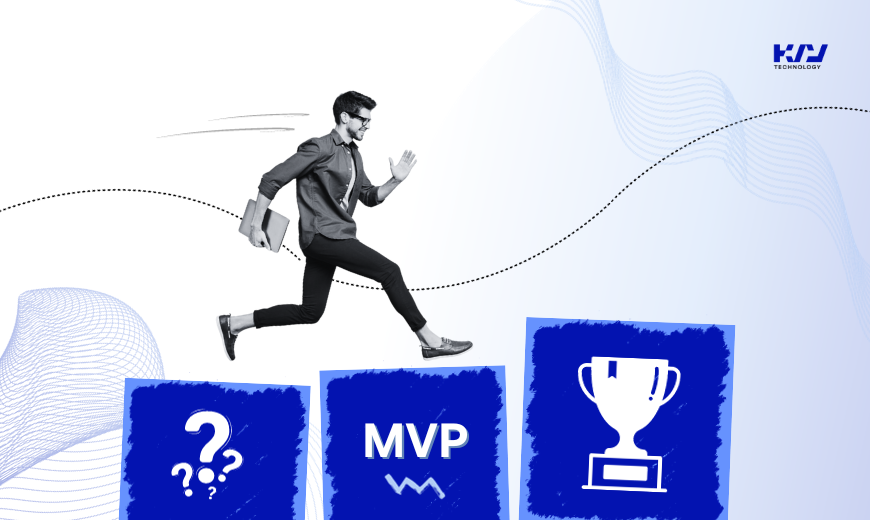
Using a Minimum Viable Product approach to test an idea is not a new concept anymore. In fact, well-known Uber, Dropbox, Figma, and Slack started their way to unicorn status with MVPs.
Although it is a very common approach, not many Singapore startup leaders have a detailed understanding of the Minimum Viable Product approach. This shortage could lead to inefficiency, unnecessary, and resource-consuming.
In this article, we’ll provide you with all things you need to understand the Minimum Viable Product approach better. After this post, you can explain what the Minimum Viable Product approach is and how important it is for your business success, what is the best framework to follow, and how to manage a Minimum Viable Product (MVP) project.
So, without further ado, let’s dive in.
1. What is the minimum viable product approach
The minimum Viable Product approach was first used by Frank Robinson and popularized by Eric Ries, founder of the Lean Startup methodology. To learn more about the benefits of Minimum Viable Products (MVP) in business, this article might be helpful to you.
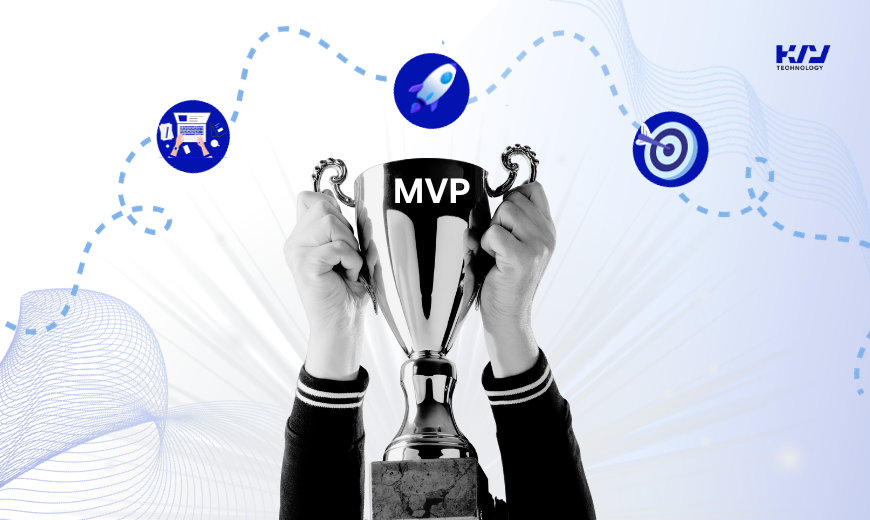
In the words of Ries, a Minimum Viable Product approach is the very basic version of a new product with enough features to run. This concept allows the team to gather the maximum amount of potential customer feedback with the least amount of effort.
In fact, the definition of the Minimum Viable Product approach doesn’t end there. From only one, we now have 5 types of Minimum Viable Product approaches in total. Some define the Minimum Viable Product approach as “the first version of a product”, while others as “ a stripped-down version of a product”.
Let’s discover.
1.1 Minimum lovable product
Minimum Loveable Product is a term coined by Brian de Haaff, founder of the roadmap software Aha!
A Minimum Loveable Product is born because the Minimum Viable Product approach, in its nature, is likely to leave customers frustrated and cause them to look for alternative solutions.
The primary goal of using Minimum Loveable Product is to create enough functionality but still attract customers. Then they will be more likely to adore the product immediately after launch, not just tolerate it.
The only disadvantage is that it could drive an unnecessary increase in the cost of development.
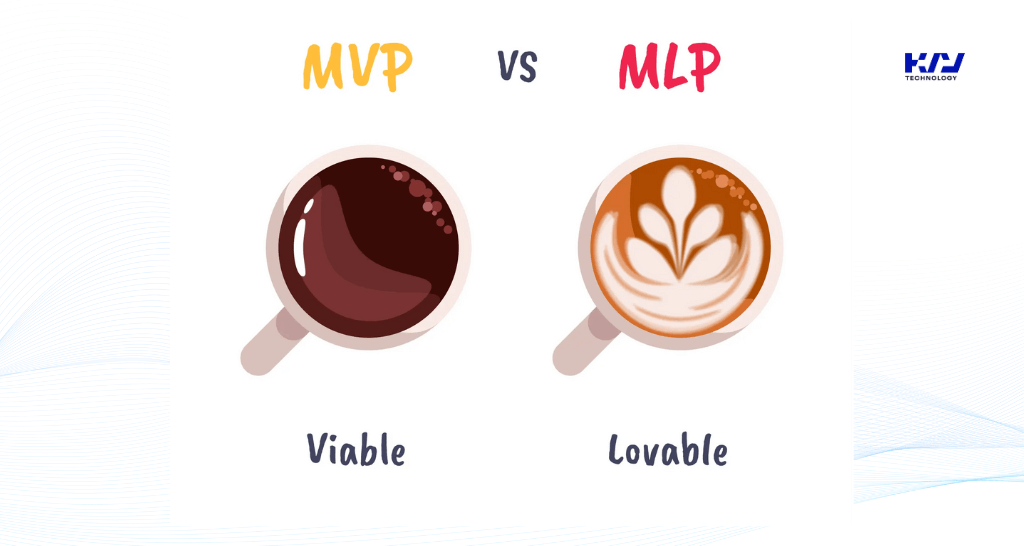
1.2 Minimum marketable product
“Minimum Marketable Product” is first mentioned in the book Software by Numbers by Mark Denne and Jane Cleland-Huang.
By definition, an MMP approach is about creating a minimum set of features to test if it is going to be in demand. It is the mix-match between minimum viable and loveable products.
It might work best for those who:
– Have already built a target user base
– Have already had its name in the market
– Have a solid understanding of the problem they’re trying to solve with a product
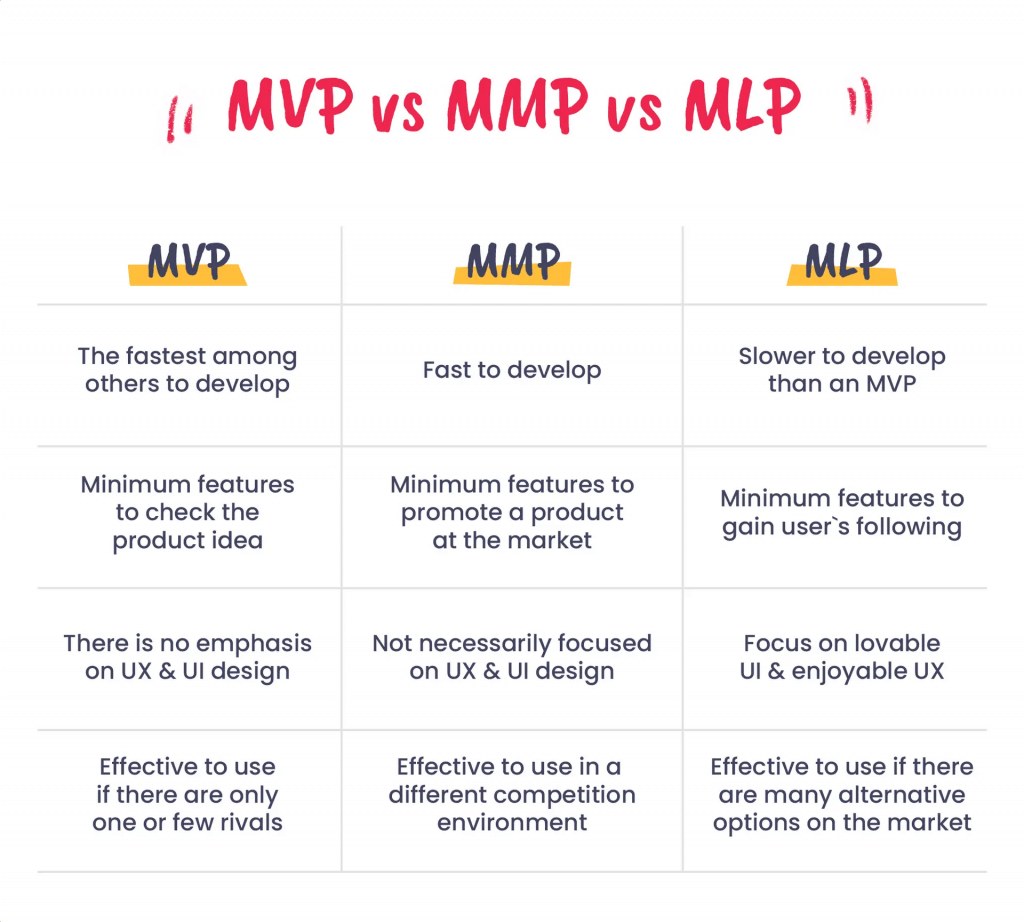
1.3 Minimum catchy offer
You can see Minimum Catchy Offer in the form of a description or a sentence that covers the basic idea.
When a product means something complex, the minimum catchy offer can be a request that is quick, clear, and understandable.
Remember Travis Kalanick’s phrase about Uber: “You push a button, and in five minutes, a Mercedes S-Class or Town Car comes and picks you up and takes you where you want to go.”
This approach is an excellent example of MCO, it helps your customer easily imagine what the product will look like and what’s in it for their benefit.
1.4 Lean investor
Dislike the initial purpose of the Minimum Viable Product approach, the Lean Investor approach is to first attract an investor. You can build a product that has its unique features. Then you can persuade the investors that your product is worth their money.
2. Minimum viable product plan
Now you’re aware of the Minimum Viable Product approach. Next, we will guide you on how to make a plan for a Minimum Viable Product (MVP). Here are 3 simple necessary steps to take before kicking off your project on Minimum Viable Product (MVP).
– Make something people want
– Validate your idea before you build an MVP
– Prepare metrics to decide what goes in the MVP
2.1 Make something people want
There is no magic pee in becoming a successful business. Every success story follows this formula: Sell what people want to buy.
Building a product goes the same way. The goal of developing software/products is to solve specific problems for users.
Therefore, make sure that you are bringing a useful idea into the market. By doing so, your product can quickly go to market. Not only this, building a product that users will use can also make marketing the product easier.
2.2 Validate your idea before you build an MVP
We already know a good product is something that solves a problem for customers. So what? How should we validate our idea before deciding on building a Minimum Viable Product (MVP)?
You might have been confused. Let us ease that pain once and for all by helping you know when to build an MVP.
You should use the Minimum Viable Product approach when your idea is relatively new, and you want to test the water. When the idea has not been validated by actual users, it is better to start small and keep building it step-by-step.

But in cases where you already have enough feedback to prove that the product is needed by the end users, you do not need to use the Minimum Viable Product approach.
To sum up, MVP is just a perfect idea to test how your new product behaves in the Singapore market. For a matured product idea, you obviously do not necessarily need to take the Minimum Viable Product route.
2.3 Metrics to decide what goes in the MVP
Let’s say you consider your idea to be relatively new and decide to choose the Minimum Viable Product approach. Then, the next question you must ask yourself is what features your Minimum Viable Product (MVP) should have.
Now, we will give you simple metrics based on which you can better decide what needs to be built and taken care of while using the Minimum Viable Product approach.
Step 1: Make a list of all the features that you will want to have in your product
Step 2: Categorize these features into two buckets, one for “product does not exist without this” and another for “good additional features”
That’s how WhatsApp did. WhatsApp is one of the most popular messaging apps today with a user base of over one and a half billion. In 2009 It was launched as an app that would publish current notifications of a person to the entire network, that was the only feature available in the app, then. This was to make use of newly launched push notifications by Apple.
In the next version of WhatsApp which was released 3 months later, messaging was introduced in the app, this made a huge impact. Make a note, that this was just text messaging, sharing of images and videos was enabled later on. Voice Call was added to the app as late as 2014.
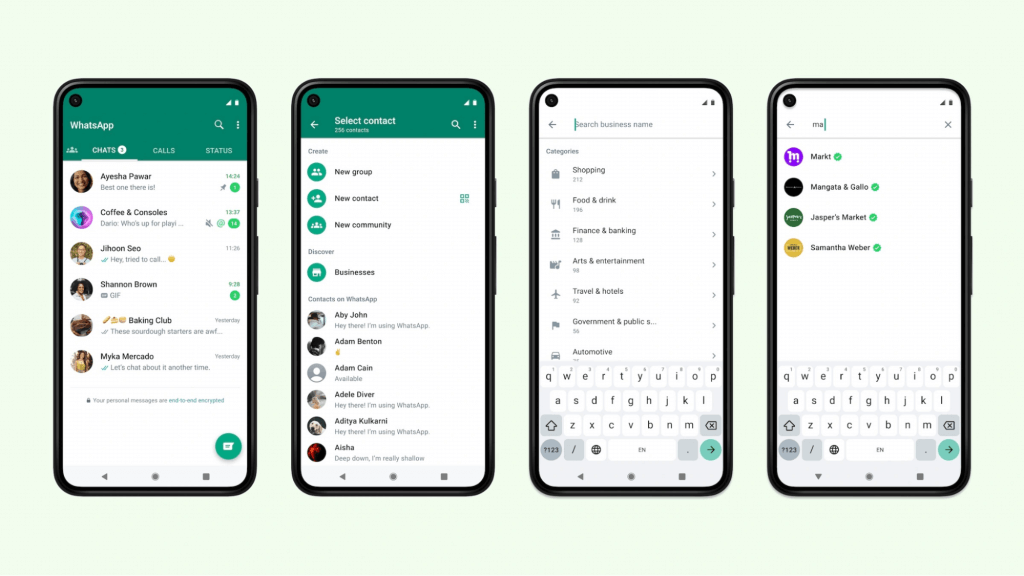
Whatsapp is a perfect example of a lean startup, the engineering team before getting acquired by Facebook was as small as 32 engineers. They managed and served millions of users with this team without any significant outages or downtime.
Every product that you use today will have a similar story, Facebook, which was launched in 2004, did not have a mobile app as recent as 2009. The Facebook that you use today was not built and launched in one go!
From this plan, we can break it down into one framework with 3 steps in total. Let’s discover!
3. Minimum viable product (MVP) framework
3.1. Identify and understand the business needs
“Why the product should exist?” Answering this question is a good start to identifying and understanding the business needs.
Follow the following 2-step guide to discover the core goal of the product.
– Determine the long-term goal of the product and write it down: Answer this simple question: Why are you doing this project?
– Identify the success criteria that will indicate whether the product is successful
3.2. Find the opportunities
3.2.1 Map out the user journey(s):
The user journey is most easily divided into three parts: the user, user actions, and story endings.
- Identify the user(s). These are the people who will be using your product. It’s possible that you will have more than one category of users. For example, if you have a service appointment booking app, you may have both the appointment scheduler (customer) and the service technician.
- Identify the story endings. For each user, there will be a story ending, which is the end goal of the user.
- Identify the jobs (actions). The jobs are the actions that the user or users need to take in order to reach the story ending and achieve the goal.
3.2.2 Create a “pain and gain” map for each action
The pain and gain map allows you to identify all user pain points and the gains the user achieves when each is addressed. This exercise lets you determine where you have the most significant potential to add value. You are then able to focus your Minimum Viable Product approach on these areas while adding the less impactful ones to the product roadmap for future releases.
- Write down the actions the user needs to complete. List the actions that you identified when mapping out the user journeys.
- Write down the pain points for each action. The pain points are brief summaries of the problems or inconveniences that users have when trying to complete that action.
- Write down the gain for each action. The gain is what value is achieved when that pain is addressed.
Use “How might we” statements or a similar method to summarize the pains and gains you have identified
3.3. Decide what features to build
In this stage, you will be able to discern what features to include in your Minimum Viable Product approach, as well as the features to include on the product roadmap that is a lower priority.
3.3.1 Use opportunity statements to finalize your features
Using your opportunity statements from the previous step, finalize what features you want to build out. At this stage in the Minimum Viable Product development process, you will want to create feature sentences. For our Pet Adopters who are applying to adopt animals, for example, the opportunity statement “How might we expedite the application process?” could become “Reduce application processing time by 10%.”
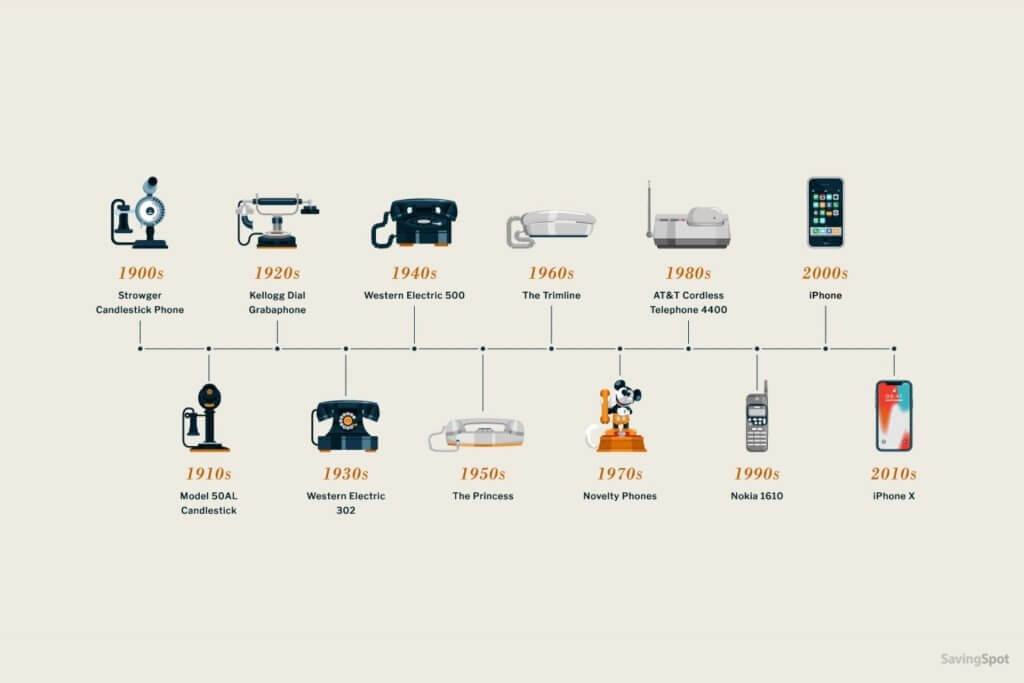
3.3.2 Provide a breakdown of the features to include in the product roadmap
List the user and the specific opportunity statements, and provide a breakdown of the features to include in the product roadmap.
3.3.3 Use a prioritization matrix (or similar method) to prioritize features
This step helps you identify where you can make the most impact on your product in relation to the urgency of the feature. Using a prioritization matrix, you can make the final decision on what absolutely needs to be included in your minimum viable product (MVP), and what features can be included in later releases. Below is our recommended format for your Minimum Viable Product (MVP) prioritization matrix.
Final thought
It’s always wise to build quickly, fail fast, and iterate. So, don’t underrate the basic version of your product. Let’s start small with the Minimum Viable Product approach and complete your ideal product step-by-step.
If you have any questions regarding Minimum Viable Product (MVP), feel free to contact KVY TECH


